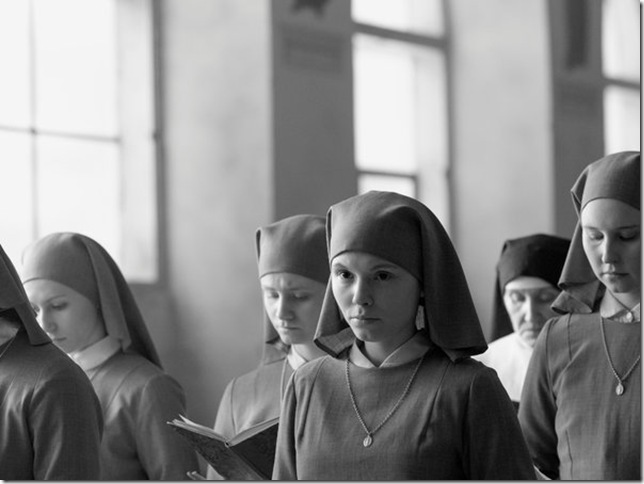In the Polish import Ida, the sky is always overcast, the interiors are as sparse as monasteries, nobody ever smiles, and they don’t speak very much, either. It goes without saying that it’s photographed in black-and-white; it’s that kind of art-house movie. As much as I hate the qualifier “it’s not for everyone,” this is one of those films that’s not for everyone.
But adventurous moviegoers who approach this contemplative coming-of-age story with the right mindset will be instantly hooked under the film’s hypnotic spell. It’s set in a frostbit Polish winter in the early 1960s, where Anna (Agata Trzebuchowska), a young, orphaned novitiate, is sent on a short pilgrimage to meet her aunt Wanda (Agata Kulesza), her only living relative, prior to taking her vows to become a nun. Wanda is, to put it mildly, not like her ascetic niece. She smokes. She drinks. She’s promiscuous. And, to Anna’s surprise, she’s Jewish — as is Anna, whose birth name is Ida, and whose parents were rounded up by the Nazis.
Much of the remainder of this brief (80 minutes) but thematically hefty drama follows their travels around a drab, postwar Poland in their efforts to track the whereabouts of Ida’s late parents, and the dark heritage she didn’t know she had.
The screenplay, co-scripted by director Pawel Pawlikowski, is classicist in its road-movie paradigm of launching an odd couple on a life-changing journey.
But the chasm between Wanda’s liberated culture and Ida’s cloistered upbringing is one of many clashes the film explores; it’s also about the confrontation of religions — Catholicism and Judaism — and political philosophies: fascism and Communism (Wanda’s former job as a prosecutor of Nazi war criminals led to her nickname, Red Wanda). It’s a movie caught in these multiple fluxes. If Ida’s life thus far has been a myth spun for her own safety, Poland itself is a more deliberate study in reinvention, blocking out its tortured World War II past like a bad trip, burying it and smoothing it over.
These confrontations find a visual mirror in Pawlikowski’s radical shooting style. Every frame looks like a painting or photograph, but most would belong in a modern art museum, not a fine art fair. His compositions suggest the formal rigor of the French maestro Robert Bresson, who would often “behead” his characters at the top of the frame, or linger on their appendages at the expense of their faces. Pawlikowski’s framing can be even more severe than Bresson’s; the few dialogue-driven scenes in Ida are generally presented with the characters’ mouths and sometimes their noses cut off by the bottom of the frame, so that we can only see their foreheads and the vast stretches of wall and sky above them; even the subtitles migrate to the center or top of the frame in these instances.
While I can’t get into the director’s head as to the nature of these fascinating — and potentially alienating — decisions, I would surmise that by cutting his characters off, he’s implying that Ida and Wanda are cut off from society, their identities severed. At any rate, it certainly grants the film its uncompromising distinction, and is a tremendous artistic advance over the director’s previous effort, the dull Anglo thriller The Woman in the Fifth.
There’s no parsing the inevitably tragic turn of events that Ida takes, but each beautifully de-dramatized moment feels like a necessary cleansing, a sacrifice at the altar of progress. When Ida emerges from the other side, she’s a self-determined person, finally in control of her past, her future and her destiny. If Ida were to have a sequel, it might just be in color.
IDA. Director: Pawel Pawlikowski; Cast: Agata Trzebuchowska, Agata Kulesza, Dawid Ogrodnik; Distributor: Music Box; Rating: PG-13; In Polish with English subtitles; Opens: Friday, June 20 at Movies of Lake Worth, Lake Worth Playhouse, Movies of Delray, Regal Shadowood 16 in Boca Raton, Living Room Theaters at FAU, the Classic Gateway Theater in Fort Lauderdale, and the Coral Gables Art Cinema (the Gables Cinema will be showing the film exclusively in 35mm).
